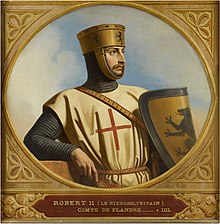Robert II, Count of Flanders
| Robert II | |
|---|---|
 Seal of Robert II | |
| Count of Flanders | |
| Reign | 1093 - 1111 |
| Predecessor | Robert I |
| Successor | Baldwin VII |
| Born | c. 1065 |
| Died | 5 October 1111 (aged c. 46) Meaux, Kingdom of France |
| Spouse | Clementia of Burgundy |
| Issue | Baldwin VII of Flanders |
| House | House of Flanders |
| Father | Robert I of Flanders |
| Mother | Gertrude of Saxony |
Robert II, Count of Flanders (c. 1065 – 5 October 1111) was Count of Flanders from 1093 to 1111. He became known as Robert of Jerusalem (Robertus Hierosolimitanus) or Robert the Crusader after his exploits in the First Crusade.
Early life
Robert was the eldest son of
First Crusade
After becoming count in 1093, Robert joined the

Robert then participated in the
At the end of 1097 the crusaders arrived at
The dispute delayed the crusade even further. Raymond left Antioch to attack
At the end of August, Robert returned home with Robert Curthose and Raymond. On the way back they captured Latakia, which was returned to the Byzantine emperor, as promised years before. Raymond remained there but both Roberts continued home by way of Constantinople, after declining Alexius' request to stay there in his service. Robert brought back with him a precious relic, the arm of Saint George, a gift from Alexius. The relic was placed in the church of Anchin Abbey in Flanders.[7] After he returned, Robert built the monastery of St. Andrew in Sevenkerke (now Zevenkerke, near Bruges.[8] Because of his crusade and the spoils he brought home, he was nicknamed Robert of Jerusalem.
Later life

During his absence,
In 1103 he made an alliance with
Family
He married
References
- ^ a b Runciman 1951, p. 166.
- ^ Paul 2012, p. 40.
- ^ a b Nicholas 2013, p. 58.
- ^ Kostick 2008, p. 257.
- ^ Runciman 1951, p. 186.
- ^ Runciman 1951, p. 244-246.
- ^ Riley-Smith 2002, p. 151.
- ^ Frankopan 2012, p. 257.
- ^ Nicholas 1999, p. 118.
- ^ Bouchard 1987, p. 146.
Sources
- Bouchard, Constance Brittain (1987). Sword, Miter, and Cloister:Nobility and Church in Burgundy, 980-1198. Cornell University Press.
- Frankopan, Peter (2012). The First Crusade: The Call from the East. Harvard University Press.
- Kostick, Conor (2008). The Social Structure of the First Crusade. Brill.
- Nicholas, Karen S. (1999). "Countesses as Rulers in Flanders". In Evergates, Theodore (ed.). Aristocratic Women in Medieval France. University of Pennsylvania Press. ISBN 978-0812200614.
- Nicholas, David M (2013). Medieval Flanders. Routledge.
- Paul, Nicholas L. (2012). To Follow in Their Footsteps: The Crusades and Family Memory in the High Middle Ages. Cornell University Press. ISBN 978-0801465543.
- Runciman, Steven (1951). A History of the Crusades: The First Crusade. Vol. I. Cambridge University Press.
- Riley-Smith, Jonathan (2002). The First Crusaders, 1095-1131. Cambridge University Press.
